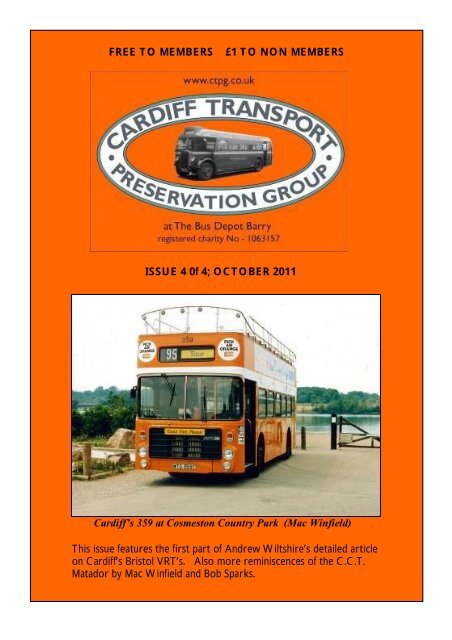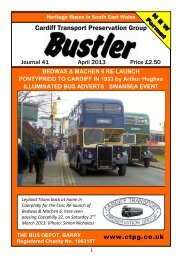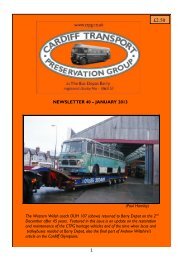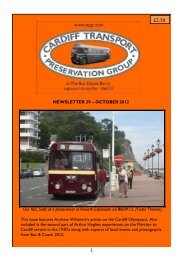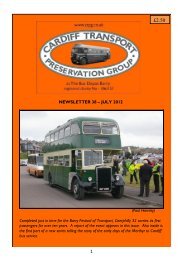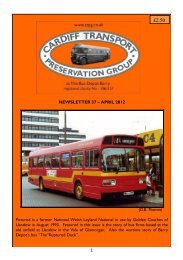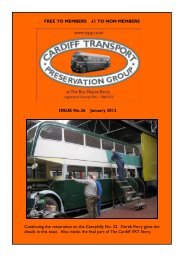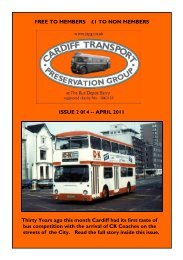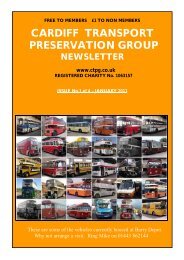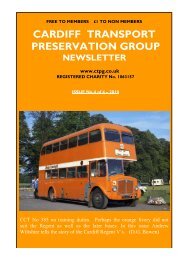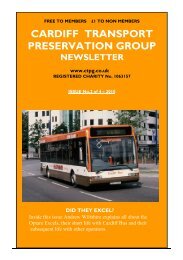You also want an ePaper? Increase the reach of your titles
YUMPU automatically turns print PDFs into web optimized ePapers that Google loves.
FREE TO MEMBERS<br />
£1 TO NON MEMBERS<br />
ISSUE 4 0f 4; OCTOBER <strong>2011</strong><br />
Cardiff’s 359 at Cosmeston Country Park (Mac Winfield)<br />
This issue features the first part <strong>of</strong> Andrew Wiltshire’s detailed article<br />
on Cardiff’s Bristol VRT’s. Also more reminiscences <strong>of</strong> the C.C.T.<br />
Chairman’s<br />
Matador by Mac Winfield and Bob<br />
Chairman<br />
Sparks.<br />
1
WWOC 856, our Leyland PS1arrived back at Barry in August after over 6 years under<br />
restoration in Scotland. Unfortunately still in an incomplete state. (Mac Winfield)<br />
“Ready for the <strong>of</strong>f” at Aberdare Bus Station on the 172 service running day in September.<br />
Ex. Red & White U1766 and Stagecoach 20387. (Martin Bray)<br />
2
CHAIRMAN’S MESSAGE;<br />
Important Notice<br />
From November’s meeting until at least the AGM in January we will be meeting upstairs<br />
at the Penarth Conservative Club in Stanwell Road, which is adjacent to the railway<br />
station and has a bus stop outside. This change has become necessary because <strong>of</strong> the<br />
retirement <strong>of</strong> our long term contact at Atlantic Wharf and the £60 “discounted” fee we<br />
would have to pay each meeting to remain. I hope those that regularly attend will<br />
continue to do so as access is better and less likely to be affected by events in Cardiff.<br />
It was nice that the weatherman was not so accurate with his prediction for the Merthyr<br />
Rally as he was for Barry for it proved to be a warm and bright day which helped make<br />
the day a success. It was the first time for us at Rhydycar and the Council have<br />
proposed that we use it again in 2012. Based on the many positive comments received<br />
on the day and afterwards, I have agreed to this proposal. I have also requested a date a<br />
week later for 2012 to allow us to run buses and open the Depot for the Tall Ships<br />
event organised by the Vale Council on the first weekend in September. Thanks to<br />
everyone who helped at Merthyr to make it a success, we managed to take nine buses<br />
from the Depot which was our highest number to date.<br />
Barry Festival <strong>of</strong> Transport & Depot Open Day will be on Sunday 10 th June<br />
2012 and the Bus & Coach Wales Sunday 9 th September 2012 at Rhydycar<br />
Leisure Centre, Merthyr Tydfil.<br />
During the summer we successfully achieved MOT’s on a number <strong>of</strong> buses prior to our<br />
rally in Merthyr. Pontypridd No.8 passed following a successful rear end rebuild and a<br />
number <strong>of</strong> mechanical problems. It last ran in 2003. The Jones Cub passed an MOT<br />
following a skim <strong>of</strong> the cylinder head a new gasket set, so far this has proved successful<br />
with no signs <strong>of</strong> the previous overheating problems. The Swift has proved to be an on<br />
going problematic vehicle. A number <strong>of</strong> different leaks and fuel problems have now,<br />
hopefully, been resolved and an MOT is planned soon along with one on the National<br />
Welsh Olympian following some remedial work. The entire CTPG collection is now in<br />
Barry following the arrival <strong>of</strong> CUH 856 from Glasgow. 856 has been undergoing<br />
restoration in Scotland for a number <strong>of</strong> years but due to a change <strong>of</strong> circumstances in<br />
Scotland it has returned part finished but we hope that it will be completed at some<br />
point soon.<br />
On 22/23 October we will be again running a classic bus service for the Cardiff Model<br />
Railway Club Show at UWIC Llandaf at Western Avenue.<br />
For those <strong>of</strong> you that enjoy your internet we have a Facebook page, I try to keep this<br />
update with photos <strong>of</strong> the happenings at Barry, the site is open to all have a look and add<br />
your own photos we have over 140 friends at the moment.<br />
Mike; Tel: 01443 753227 Email : mikeystrad73@btinternet.com<br />
3
JULY ROAD RUN; by Paul Hamley<br />
The evening <strong>of</strong> 20 July <strong>2011</strong> saw our 3 rd road run <strong>of</strong> the year, and for the 2 nd month<br />
running we were using a vehicle resident at the Barry depot. The intention had been to<br />
recreate a trip on the old N&C route as far as Neath, but problems with the planned<br />
vehicle meant we did not have the N&C<br />
coach <strong>of</strong> Jeff Phillips available.<br />
Richard Johnson brought out his Bristol<br />
MW ‘Western National’ coach at short<br />
notice. A good load <strong>of</strong> about 30 left<br />
County Hall about 15 minutes late via<br />
the A48 up the Tumble, around the<br />
Cowbridge by-pass to save time, and<br />
then headed directly into Bridgend,<br />
turning in the ‘new’ bus station (the<br />
original now under a new development).<br />
Continuing out through Laleston, we<br />
regained the A48, but as it was now well<br />
past 8 o clock, it was decided that Neath was not going to be a realistic destination. So<br />
we turned left and headed down to Porthcawl. On a pleasant summers’ evening, with a<br />
low sun in the sky, we parked up on the seafront causing much interest to the passers<br />
by. Those in the know headed for the Lorelei (real ales), some visited local seafront<br />
hotels (expensive), whilst others went on the beach or sat looking wistfully out to sea<br />
(!!!). At 9 o clock with the sun going down, we returned to Cardiff via the motorway.<br />
AUGUST ROAD RUN: by Paul Hamley.<br />
For our final road run <strong>of</strong> the year, it’s become a tradition for Mike Walker to provide<br />
one <strong>of</strong> his superbly restored Bristol area vehicles. This year was slightly different as the<br />
bus was not actually his, but was nevertheless an exceptionally comfortable vehicle.<br />
D101 GHY was the first vehicle <strong>of</strong> a<br />
batch <strong>of</strong> Volvos, both double and single<br />
deck, that were amongst the first new<br />
vehicles purchased by the new<br />
Badgerline company in 1986, and made a<br />
change from the previous standard<br />
Bristols and Leylands.<br />
We travelled via Wenvoe, St Athan,<br />
Llantwit Major along the coast road on a<br />
very pleasant evening, and arrived at the<br />
THREE GOLDEN CUPS at<br />
Southerndown just after eight. The pub<br />
has much to commend it (especially ‘Sharps Doom Bar’), and the 25 or so members<br />
enjoyed the evening warmth, and even a walk to the clifftop, before the trip home via the<br />
coast through Ogmore, then Ewenny and Bridgend.<br />
4
THE BUS & COACH WALES <strong>2011</strong>; by Paul Gilbertson.<br />
The festival was held at a new venue in Merthyr Tydfil this year, namely the Rhydycar<br />
Leisure Centre, on the first Sunday in September. As well as buses & coaches, the usual<br />
array <strong>of</strong> classic cars and commercial vehicles adorned the event. The weather behaved<br />
impeccably for most <strong>of</strong> the day and the new venue was well received by members and<br />
enthusiasts alike and also brought families out in their droves.<br />
On the bus & coach front the Barry Depot supplied some eight vehicles and as always<br />
newly restored vehicles continue to appear.<br />
The ex. WWOC Renown <strong>of</strong> Tony Jenkins with the ex. N&C Reliance <strong>of</strong> Jeff Phillips. (V.C.)<br />
This year the ex Pontypridd Urban District Council No. 8, AEC Regent V double decker<br />
UTG 313G, made the festival, superbly restored by CTPG members. It was also pleasing<br />
to welcome John Shearing and his ex Kowloon Motor Bus Co. AEC Regent V, ABW<br />
225D which carries up to 114 passengers.<br />
Two former N & C coaches made an appearance for the first time together for many<br />
years, following extensive maintenance. Both these coaches were AEC Reliances <strong>of</strong> the<br />
1960s. WWN 191 entered by the Swansea Group, has a Harrington Cavalier body and<br />
PTX 830F, entered by Jeff Phillips, a Plaxton body which saw service with Western<br />
Welsh at the Barry Depot following the demise <strong>of</strong> the N & C company in 1970.<br />
The furthest travelled bus was a former Red & White Bristol MW, JAX 117E, owned by<br />
David Bateman <strong>of</strong> Chelmsford, that was based in its working life at the Gadlys Road<br />
5
Depot, Aberdare. As well as the vehicles on display, the general public were treated to<br />
tours <strong>of</strong> Merthyr, Brecon Mountain Railway Centre and the Rhymney Brewery at<br />
Dowlais. As usual long queues persisted all day for these popular trips.<br />
Once again, I would like to <strong>of</strong>fer a big thank-you to all our sponsors too numerous to<br />
mention by name and to all the groups members who gave freely <strong>of</strong> their time to make<br />
the event a great success.<br />
---------------------------------------------<br />
172 SERVICE RE-VISITED; by Mac Winfield<br />
With the weatherman not promising much in the way <strong>of</strong> sunshine, we set out as<br />
advertised from Barry Depot at 0930 on Saturday 10 th September. A good crowd had<br />
gathered for the trip in David & Sue Bateman's fine, former Red & White Bristol MW<br />
U1766, JAX117E. At Cardiff, the destination blind was showing “175 Aberdare via<br />
Pontypridd”. Alan Jones (late <strong>of</strong> National Welsh, Aberdare Depot) drove on the first leg<br />
<strong>of</strong> our journey from Barry to Bridgend via Cardiff, Aberdare and Tonypandy.<br />
Conditions remained a<br />
little overcast but dry at<br />
least, on the leg to<br />
Aberdare. It wasn't long<br />
before we were passing<br />
through such towns as<br />
Abercynon, passing<br />
under its 10' 9" railway<br />
bridge and negotiating<br />
the narrow one-way<br />
system, then on toward<br />
Mountain Ash and<br />
Abercwmboi (now<br />
completely pollution<br />
free) before entering<br />
Aberdare, one <strong>of</strong> the<br />
most pleasant and<br />
vibrant Welsh valley<br />
towns.<br />
A long lunch stop was<br />
David & Sue Bateman at Barry with U1766 (P.Hamley) taken with most <strong>of</strong> our<br />
party visiting the local<br />
"Wetherspoons" for a drink and a bite to eat. Your web-master and David stayed<br />
behind to fix a throttle operating problem that had caused some difficulty on our<br />
outward journey. We found that a throttle stop screw was not reaching its intended<br />
stop point causing the mechanism to jam, once found this was soon rectified and gave no<br />
6
further trouble. Our bus caused much interest among the Aberdare Stagecoach bus<br />
crews and the locals alike, a number asking questions about the bus and reminiscing over<br />
past times.<br />
We were now ready to set out on the mammoth 172 route from Aberdare to<br />
Porthcawl. Alan had spoken to the waiting service driver and agreement was made for<br />
him to clear the road for us over the mountain to Maerdy.<br />
We stayed in fairly close formation with Stagecoach 20387 (R787 DHB), a 13 year old<br />
Volvo B10 with Alexander bodywork, all the way to Porthcawl sometimes with our 45<br />
year old bus leading, though we stopped for several photo calls on route.<br />
Rain came down almost to order over the mountains in typical Welsh fashion, but we<br />
were not deterred. Now the engine was running well and we soon were passing<br />
Ferndale, Penrhys, Tonypandy, Penygraig and Gilfach Goch before dropping down into<br />
Blackmill heading for Aberkenfig before arriving at Bridgend's new bus station. There a<br />
crew change was made with Wayne Lewis taking over the controls. The sun was now<br />
shining for our trip through Laleston to Porthcawl, where another short break was<br />
taken. Once again re-united with the Stagecoach service bus, a photo opportunity was<br />
taken before our departure for Barry Depot via the sea front and A48.<br />
I'm sure I can speak for all who took part when I say it was one <strong>of</strong> our best local trips <strong>of</strong><br />
the year and we thank David and Sue for the opportunity they afforded us to travel on<br />
their remarkable MW. We certainly hope they enjoyed the day as much as we did and<br />
will visit us again next season.<br />
--------------------------------------------<br />
SEPTEMBER MEETING;<br />
Over 30 attended the joint annual meeting with the Omnibus Society. The talk was<br />
given by Richard Davies, the Commercial Manager <strong>of</strong> Stagecoach in South Wales.<br />
Mr. Davies told <strong>of</strong> his background in consultancy at both London and Hong Kong. When<br />
in 1992 he was seconded as Planning Manager to the main bus operator on the island,<br />
China Motor Bus, they operated 1006 buses. Leaving CMB in 1998, Mr. Davies joined<br />
the fledgling New World First Bus Co. as Assistant to the M.D. It was interesting to<br />
learn that 90% <strong>of</strong> the population <strong>of</strong> Hong Kong use public transport.<br />
Mr. Davies later returned to the U.K. and joined Stagecoach in South Wales. The<br />
company has depots at Aberdare, Blackwood, Brynmawr, Merthyr, Porth and an<br />
outstation at Brecon. Currently the company has 365 buses (only 3 d.d.) and 713<br />
drivers. His talk concluded by recalling the logistical nightmare <strong>of</strong> providing 140 double<br />
deck buses for the park & ride at the 2010 Ryder Cup at Newport. Teamwork made<br />
possible the procurement <strong>of</strong> these buses from every Stagecoach company in the U.K.<br />
--------------------------------------------<br />
7
SOME MORE MATADOR MEMORIES:<br />
“My memories <strong>of</strong> the Cardiff Matador” by Bob Sparks<br />
(Fitter at Sloper Road Depot 1980-1996).<br />
During the heavy snow <strong>of</strong> the early 1980s, the Matador was in constant use by the<br />
service fitters and garage staff, assisting and recovering stranded buses all over the city.<br />
Along with our Land Rover, these two vehicles proved their worth in the adverse<br />
conditions with their 4 wheel drive and low ratio capability. It was used on rare occasions<br />
to recover a bus that the Leyland Chieftain (our roving repair vehicle) could not cope<br />
with, or towing buses around the depot, Due to the age <strong>of</strong> this vehicle, the occasional<br />
mechanical breakdown could not be ruled out.<br />
One evening the service fitter found that the air braking system was not building up<br />
pressure, on closer inspection he found that the compressor which was attached and run<br />
<strong>of</strong>f the gearbox had broken away from the main casing rendering it unserviceable.<br />
The old girl was put on the pit and I and another fitter had a closer inspection <strong>of</strong> the<br />
damage and we could see that the main gearbox casing was beyond a temporary repair<br />
and would have to be completely dismantled. Even then, we were not sure if it could be<br />
repaired. A decision was made to try and source another complete gearbox to get the<br />
much needed old girl back in operation.<br />
8
Luckily Newport Transport had a redundant Matador <strong>of</strong> their own at their Corporation<br />
Rd. Depot and arrangements were quickly made to remove the gearbox and fit it in ours,<br />
though, more easily said than done.<br />
Bearing in mind the snow was still causing major problems, with most roads still difficult<br />
to drive on, never the less myself and two other members <strong>of</strong> the garage staff were<br />
dispatched to Newport with tools, ropes, jacks and shovels which we loaded onto a<br />
spare "F shed” (Cardiff Bus parlance for one <strong>of</strong> the early Daimler Fleetlines, 474-489 or<br />
490-505, the latter also known to Sloper Rd crews as “Roath Sheds”) as it was all that<br />
was available and so we proceeded up to Newport.<br />
What greeted us when we<br />
arrived was a bit daunting, the<br />
old Matador was stuck down<br />
the side <strong>of</strong> a building with spare<br />
bus parts all around it and<br />
wedged in by a scrap single<br />
decker and if I recall correctly,<br />
a preserved Western Welsh<br />
Renown, plus <strong>of</strong> course, all<br />
covered in about a foot <strong>of</strong><br />
snow. We got to work<br />
clearing a path to the vehicle,<br />
and trying to access the said<br />
part was not an easy task,<br />
Undaunted we shoveled our<br />
way in like some polar<br />
explorers and after a couple <strong>of</strong><br />
hours <strong>of</strong> dismantling and many<br />
hot cups <strong>of</strong> tea, the gearbox<br />
emerged from where it had<br />
languished for many years.<br />
We managed to drag the<br />
gearbox past the obstructions<br />
to load it onto the platform <strong>of</strong><br />
our Fleetline for the return journey to Sloper Road, where after some checking and<br />
cleaning, the replacement box was fitted into the old girl. Away she went, back into<br />
service. I believe some months later it was decided to purchase the whole Matador from<br />
Newport and it was towed to Roath depot where it was broken up for spares. I must<br />
say I was very fond <strong>of</strong> our Matador and was one <strong>of</strong> a small group who could drive this<br />
beast and used it several times in my career recovering vehicles for Cardiff Bus.<br />
9
“My Matador Memories” by Mac Winfield (CCT 1973-78 & 1983-2010)<br />
My first encounter with the Cardiff Matador was on the evening <strong>of</strong> 20 th February 1962. My<br />
friend Richard and myself heard on the Ely grape vine (from two other kids) that a bus had<br />
just crashed at the bottom <strong>of</strong> Archer Road and, being quite close, we immediately set <strong>of</strong>f at<br />
top speed to investigate. On our arrival about two or three minutes later we were<br />
intrigued to see a Cardiff Bristol K type number 119 astride two front gardens <strong>of</strong> the<br />
houses on the north side <strong>of</strong> the junction with Plymouthwood Road.<br />
The bus was balanced precariously with its nearside wheels in the gardens and the <strong>of</strong>f side<br />
ones on the pavement, the whole vehicle leaning dangerously toward the road. As far as I<br />
can remember there were no police cars in attendance and Panda Cars were still six years<br />
away. From what we could gather, the driver had swerved to avoid a child who had run<br />
out into the path <strong>of</strong> the bus.<br />
The Matador with training bus No. 78 on tow. c. 1966.<br />
No red tape, no cones, no radios, no flashing lights and no crowd control <strong>of</strong> any sort, in<br />
1962. Although the bus had mounted the kerb, garden walls and front gardens, damage<br />
seemed slight, (though it was a Bristol, so pretty indestructible) what damage could be<br />
seen was confined to the radiator, drivers windscreen and ro<strong>of</strong> dome. On its visit to the<br />
gardens it up-rooted and totally destroyed a concrete lamp column but not before the<br />
lamp’s lantern made contact with 119’s ro<strong>of</strong>.<br />
10
Enter the Matador: It wasn’t long before we heard a distant growl, something big and red<br />
was climbing Plymouthwood Road hill, slowly coming into view. Covered in a very dark<br />
shade <strong>of</strong> crimson lake and unlike the buses it carried no cream relief, it seemed to us to<br />
be a huge, but undoubtedly AEC, breakdown truck.<br />
After assessing the damage and laying down some large pieces <strong>of</strong> wood, which looked a<br />
bit like railway sleepers, the crew <strong>of</strong> the Matador set about retrieving the bus. The winch<br />
wire was connected to the back <strong>of</strong> 119 and all the gathered kids were told to stand clear.<br />
With a driver now in the cab <strong>of</strong> 119 and chocks under the wheels <strong>of</strong> the Matador the<br />
recovery began. The wire rope tightened as the revs rose and 119 began to move, the<br />
bus wobbled as its wheels climbed over the wooden planks but was very gently pulled<br />
clear revealing crushed garden walls and a fragmented lamp column laying where it fallen<br />
on the pavement, like a vanquished protagonist in some sort <strong>of</strong> medieval contest. The bus<br />
was quickly examined by the breakdown crew before being hitched up to the now repositioned<br />
Matador for a suspended tow to the depot.<br />
The Matador at Castle Street c.1964. Note the pile <strong>of</strong> rubbish (It’s a Triumph Herald 12/50)<br />
The above was my first encounter with the Matador and little did I know there would be a<br />
much more personal encounter some 16 years later when it was called upon to rescue<br />
open-topper 434 from Castle Coch on Easter Monday 1978. Without going into too<br />
much detail, 434 became stuck in the s<strong>of</strong>t verge <strong>of</strong> the steeply graded entrance road to<br />
the Castle. The front nearside wheel became well and truly embedded and with the<br />
11
<strong>of</strong>fside rear wheels almost clear <strong>of</strong> the road there was no way any traction could be<br />
obtained. One embarrassing phone call later the service fitter was summoned, about half<br />
an hour later the Leyland Chieftain (call sign “KILO”) arrived. The bus station inspector<br />
also turned up in one <strong>of</strong> the Commer vans and I’m glad to say, promptly also got stuck<br />
(lucky for me I thought how will he explain this). The Chieftain was unable to tow the bus<br />
out due in the main to insufficient traction, though it did manage to release the inspectors<br />
van, ah! A call was then put through from the Chieftain’s radio, “KILO to CARTOW<br />
BASE we need the Matador.” “ROGER KILO” was the response.<br />
Two hours later (well, it was Easter Monday) that distant growl was heard again. The<br />
now yellow Matador fitted with a 2-way radio, cab mounted “Towing” sign and flashing<br />
amber light was climbing Castle Coch hill. Jimmy Knowles our resident “Cheerful<br />
Cockney” service fitter had arrived! With 20 years <strong>of</strong> Army towing experience and an<br />
unending supply <strong>of</strong> Anglo-Saxon expletives he was sure to do the job.<br />
Jimmy took the Matador carefully past the bus and parked up about 30mtrs beyond, then<br />
after chocking all his road wheels wound <strong>of</strong>f the wire rope from the rear winch, after<br />
connecting to the front axle <strong>of</strong> 434 he was ready for the big pull, with the Matador in<br />
winch mode and engine revving the wire rope took the strain all our attention was on the<br />
bus wondering when it would move, looking up the road to see if all was OK. Shock<br />
horror! the Matador was on its way down the hill being hauled in by the winch all wheels<br />
still locked and skidding along the tarmac - chocks an’all.<br />
“Oh…****” said Jimmy, “this isn’t going to work. There’s only one way out <strong>of</strong> here and<br />
that’s the way it went in.” Easier said than done! We had to wait until 6pm, (having got<br />
stuck at around 11am) this being due to the volume <strong>of</strong> visitor traffic at the Castle. Once<br />
we managed to get the Matador behind the bus and facing the right direction we were in<br />
business again with the wire rope now around the rear axle. I was asked (I say asked) to<br />
get in the cab. I think they thought it might topple over on its way out as it was leaning<br />
heavily. Thunderous revs from the Matador saw 434 climb out <strong>of</strong> the ditch with me<br />
hanging on to the steering wheel with as much left-hand down as I could muster and feet<br />
firmly placed on the near-side cab window frame due to the angle <strong>of</strong> the bus. A slow<br />
drive back to the depot via Northern Ave and Manor Way in the shadow <strong>of</strong> the<br />
Matador driven by Jimmy, with lumps <strong>of</strong> mud flying <strong>of</strong>f the wheels in all directions we<br />
entered Sloper Rd Depot greeted with a cheer from the night staff at 7pm then<br />
someone shouted, “Stick it on 18 road”. The Matador had earned its keep once more.<br />
(Many thanks to Glyn and Mac for the photographs and for encouraging Gordon, Mac and Bob<br />
to share their reminiscences <strong>of</strong> the old Matador. Another Cardiff recovery vehicle remembered<br />
was NUT 344W the ERF “B Series” with Gardner engine. This was new in 1/81 as a tractor<br />
unit in Leicestershire and purchased 1/86 by CCT and converted to recovery truck by West-Mid<br />
Trucks at West Bromwich. It entered service 10/86. I understand this is still owned by Cardiff<br />
Bus, but not in use. Ed.)<br />
---------------------------------------------<br />
12
CARDIFF’S BUSES by Andrew Wiltshire;<br />
The Series 3 Bristol VRTs<br />
Fleet numbers: 301 to 397<br />
Registration number: SWO 301-326S<br />
WTG 327-381T<br />
CTX 382-397V<br />
Chassis type:<br />
Bristol VRT/SL3/6LXB<br />
Engine type:<br />
Gardner 6LXB 10.45 litre<br />
180bhp @1850rpm<br />
Gearbox:<br />
Self Changing gears G2 5 speed with<br />
CAV511 automatic transmission controllers<br />
Wheelbase:<br />
16ft 2in<br />
Brakes:<br />
Air (dual line split-system)<br />
Suspension:<br />
Semi-elliptic leaf-springs<br />
Body manufacturer: Willowbrook, Loughborough (301-326)<br />
Alexander, Falkirk (327-397)<br />
Seating layout: H43/31F (301-326)<br />
H44/31F (327 to 358,361 to 397)<br />
CO44/31F (359/60)<br />
Overall height:<br />
14ft 6in<br />
Unladen weight:<br />
9573kg<br />
Years built: 1977 to 1980<br />
Depot allocation as new: Sloper Road: 306-26<br />
Roath: 301-305 (308-312 from 6/78)<br />
Dates <strong>of</strong> withdrawal: 1988 to 1999<br />
The original Bristol VRT chassis was introduced to service in 1968 with much haste, and<br />
with this came many teething problems. The series 2 version introduced in 1970<br />
provided a solution to many <strong>of</strong> these original faults. The Series 3 variation on the other<br />
hand was subject to much research and development work before its launch. A<br />
prototype was built in November 1973 which was bodied by ECW and eventually<br />
entered service with NBC subsidiary Western National in 1974. This bus had the<br />
Leyland 510 engine <strong>of</strong> 170bhp which was now <strong>of</strong>fered as an alternative to the Gardner<br />
6LX. A second prototype followed with the Gardner 6LXB engine and put to work with<br />
Northern General. A dozen pre-production buses were built with Leyland 510 engines<br />
and all entered service with NBC fleets in 1975. The Leyland 501 was the engine actually<br />
used in all production chassis. However, most Series 3 VRTs were built with the<br />
Gardner 6LXB engine.<br />
Besides engine options the chassis was also <strong>of</strong>fered with fully-automatic transmission.<br />
The engine compartment was a fully enclosed affair with no external grills. Engine<br />
ventilation was achieved as follows. A fan would draw air in through a grill mounted on<br />
the <strong>of</strong>fside rear between decks. Warm air would then leave the engine compartment via<br />
13
a rear corner mounted grill also between decks but on the nearside. The Series 3 was to<br />
be the final and most successful version <strong>of</strong> the chassis. After 13 years production <strong>of</strong> the<br />
Bristol VRT was to cease in 1981. Nearly three quarters <strong>of</strong> all VRTs built were Series 3<br />
versions. Most had ECW bodies and were destined for National Bus Company fleets.<br />
East Lancs and Northern Counties (NCME) built bodies on early VRTs as well as Series<br />
3 versions. MCW only built bodies on Series 2 version whereas Alexander and<br />
Willowbrook built only on Series 3 chassis. Alexander built 132 and Willowbrook<br />
completed 83. Of the 3052 series 3 chassis built, all but 51 were the shorter VRT/SL3<br />
variant.<br />
1974 saw Cardiff Corporation place its long awaited series 2 Bristol VRTs into service<br />
after conversion to fully-automatic transmission. They settled down to work in the<br />
Capital on a variety <strong>of</strong> routes. The next new buses would be a fleet <strong>of</strong> Leyland National<br />
single deckers, which would eventually see <strong>of</strong>f the AEC Swifts. A large number <strong>of</strong> new<br />
double-deckers would still be needed to complete the conversion <strong>of</strong> all services to one<br />
man operation by the end <strong>of</strong> the decade.<br />
No. 308 at Central Bus Station on 10/4/78.<br />
(A. Wiltshire)<br />
The following double deckers would be required:<br />
1976/77 (26); 1977/78 (34) 1978/79 (23); 1979/80 (31);<br />
This made a total <strong>of</strong> 114 which was referred to as ‘26 plus 88’. Just prior to this Cardiff<br />
looked at a number <strong>of</strong> models including the MCW Metropolitan and a Northern General<br />
Bristol VRT in 1974. In February 1975 tenders were received from Bristol Commercial<br />
14
Vehicles and Walter Alexander for the supply <strong>of</strong> 26 chassis at £12.125 each and 26<br />
bodies at £8970 each. These would be required for delivery before 31 March 1976.<br />
At this point both were given the option to supply a further 88 vehicles. The Policy<br />
(Finance) Committee approved the tender for 26 on March 10 th but not for the other 88.<br />
On 3 October 1975 British Leyland (BCV) announced that they were increasing the<br />
price <strong>of</strong> the 26 chassis. The total cost <strong>of</strong> the 26 vehicles had now risen from £548,470 to<br />
£601,596. At the same meeting it was requested that the proposal for 34 vehicles for<br />
1977/78 be confirmed with Leyland (BCV) and Alexander, and that delivery be brought<br />
forward to be no later than 31 December 1977. This was because the 50% Bus Grant<br />
was finishing at that time.<br />
Not much happened then until it was announced at a meeting on 5 November 1976 that<br />
Walter Alexander would be unable to meet delivery dates for the first 26 VRTs. These<br />
would now be bodied by Willowbrook International <strong>of</strong> Loughborough at a cost <strong>of</strong><br />
£13,890 each. The buses would be delivered within eight weeks <strong>of</strong> Willowbrook<br />
receiving the chassis. The first chassis was delivered to Willowbrook in January 1977 and<br />
delivery was expected to commence late March early April time. The buses would be<br />
numbered 301 to 326 and registered PTX 301-326R. It was announced also that<br />
Alexander had promised delivery <strong>of</strong> the second batch by 31 December 1977. The order<br />
for a further 23 similar buses for 1978/79 was also confirmed.<br />
By the January <strong>of</strong> 1977 Willowbrook were working on the design <strong>of</strong> the new bodies and<br />
ordering materials for their construction in the following three months. However by<br />
March, Mr D.R. Smith the General Manager had been informed that chassis production<br />
had been delayed due to industrial action at Bristol. Things were now not looking very<br />
good. To make matters worse Bristol Commercial Vehicles were increasing their prices<br />
by 12%. The summer <strong>of</strong> 1977 arrived and there was no sign <strong>of</strong> the new buses. Things<br />
were getting desperate in the Cardiff fleet as older vehicles were being withdrawn.<br />
Rather than recertifying these buses (Guy Arab Vs), it was decided to hire in suitable<br />
vehicles to enable the conversion to one man operation to continue. And so began an<br />
interesting chapter in Cardiff’s history.<br />
Willowbrook had not bodied any batches <strong>of</strong> double deckers for a number <strong>of</strong> years. Some<br />
L reg. Fleetlines for Nottingham and some L reg. Atlanteans for Brighton spring to mind.<br />
The former were to more or less standard Nottingham style while the latter were<br />
similar to Cardiff Fleetlines 526-550. In the summer <strong>of</strong> 1977 Willowbrook started to<br />
deliver some Bristol VRTs to NBC operator Northern General. These however had<br />
Leyland 510 engines. They had a new style <strong>of</strong> body, very box like, with deep windows,<br />
and not unlike that produced as standard by MCW at the time. Of note were the odd<br />
size windows in the lower <strong>of</strong>fside <strong>of</strong> the bus. This was a taste <strong>of</strong> what Cardiff was to get.<br />
Cardiff’s examples would then be followed by a batch for East Kent with Gardner<br />
engines. Eventually in November 1977 the first two new Bristol VRTs were delivered.<br />
No’s 302 and 303 arrived on the 18 th . They were built to full height configuration. The<br />
first pair were rapidly followed by No’s 304 to 307 on the 21 st and 301 the following day.<br />
No. 303 was used on driver familiarisation from 28/11/77 and the first into normal<br />
15
service were 302 to 304 on December 1 st . Throughout December and the run up to<br />
Christmas saw No’s 308 to 322 arrive while 323-326 were delivered on 28/12/77 after<br />
being stored at Leicester’s Abbey Park garage. The last into service were No’s 322 to<br />
326 in February 1978. Many entered service without their fog light fitted. Of note is that<br />
this batch <strong>of</strong> buses introduced the new larger style fleet numbers and the first Gardner<br />
6LXB engines to the fleet. Cardiff was seeking to evaluate a Volvo Ailsa in 1978 and a<br />
deal was arranged with Scottish municipal operator Tayside Regional Transport. They<br />
would supply an Ailsa on loan for about 6 months and in exchange one <strong>of</strong> Cardiff’s new<br />
VRTs would go to Dundee. Tayside incidentally had a small fleet <strong>of</strong> long-wheelbase VRTs<br />
with dual-door Alexander bodies. The vehicle selected was No.326, and it was driven to<br />
an arranged half way point, where upon a swap was undertaken, 326 continuing north<br />
with a Tayside driver at the wheel.<br />
No. 370 on the 25 service at Barons Court Road. (Mac Winfield)<br />
At this point in time there were still a further 88 Bristol VRTs on order. This figure was<br />
reduced to 86 as the 1978/79 order was reduced from 23 to 21. The reason for this was<br />
that Cardiff had ordered in their place a Leyland Leopard coach and a new Leyland Titan<br />
double decker for evaluation. The next batch <strong>of</strong> VRTs would have Alexander bodies as<br />
originally planned. They were now due in the summer <strong>of</strong> 1978 and would be numbered<br />
327 to 360 (WTG 327 to 360T). Two would be built as convertible open-toppers. The<br />
first to arrive were No’s 327 to 332 between October 3 rd and the 12 th 1978. Buses 327<br />
and 328 entered service from Sloper Road on October 9 th .<br />
16
No’s 333 to 337 were delivered later in October followed by 338 to 341 in November<br />
and 342 to 358 in December/January. The last two buses in the batch (359/60) were the<br />
convertible open-toppers and turned up in February 1979. They were in standard orange<br />
and white fleet livery. The intention was that 359 and 360 would only be used as opentoppers<br />
in the June to August period. Their first duties as such were to the 1979 Epsom<br />
Derby for three days in early June. When they retuned to Cardiff they had their “lids”<br />
put back on. The third batch now 21 in number would be numbered 361 to 381<br />
(WTG 361 to 381T) and construction <strong>of</strong> these began at Alexanders in spring <strong>of</strong> 1979.<br />
Delivery commenced in June and by July 1979 all were present and in service.<br />
It is now known that the final batch <strong>of</strong> VRTs on order was reduced from 31 to just 16<br />
vehicles in November 1977. This was due to the purchase <strong>of</strong> 14 second hand Leyland<br />
Atlanteans at this time, to cover for late deliveries. This final batch would be numbered<br />
382 to 397 and were due by March 1980. They were delivered between February 18 th<br />
and March 25 h and some were pressed into service from March 3 rd .<br />
Ninety seven new buses;<br />
The delivery <strong>of</strong> a staggering 97 new double-deckers in just over two years saw the end <strong>of</strong><br />
half-cab operation in the Cardiff fleet in 1979. It also spelt the end for the second-hand<br />
Leyland Atlanteans purchased in 1977/78 and witnessed the withdrawal <strong>of</strong> the number <strong>of</strong><br />
early Daimler Fleetlines dating from 1967/8. A large degree <strong>of</strong> standardisation had also<br />
been achieved from an engineering point <strong>of</strong> view.<br />
None <strong>of</strong> the new Bristols could be described as attractive looking buses, which was not<br />
helped by the predominantly orange livery. The Alexander bodied VRTs (327 to 397) in<br />
my opinion were better looking than their Willowbrook counterparts, and without<br />
doubt <strong>of</strong> a far superior build quality. No’s 301 to 326 had four-piece folding doors and a<br />
fairly plain front radiator grille featuring a Willowbrook badge. They had curved<br />
windscreens and opening front upper deck vents. The Alexander examples had twopiece<br />
glider doors and a large very distinctive black radiator moulding with a standard<br />
Bristol VR badge attached. The Alexander body (designated AL) was <strong>of</strong> Aluminium frame<br />
construction and based on a design introduced in 1970. These buses had well<br />
pronounced fibre-glass moulded peaks at front and rear. It is thought that most buses<br />
from the first batch No’s 327-360, were fitted with opening vents in the top deck front<br />
windows when delivered. For some reason these gave trouble very early on as they let<br />
water in. This resulted in water leaking into the destination box and then dripping down<br />
into the cab area. These were removed and replaced by plain glass after a few months<br />
service. No’s 352 and 353 did however linger on longer than most before they were<br />
dealt with. All subsequent deliveries featured plain glass. Five sliding ventilators were to<br />
be found on each deck on each side <strong>of</strong> the vehicle.<br />
To ride on as a passenger, the series 3 VRTs were not particularly lively or comfortable<br />
buses. They featured brown vinyl seats on both decks and a fibreglass bench at the rear<br />
on the top deck. They were very noisy in the lower saloon, but were not as cramped as<br />
the earlier Series 2 buses (586-605) which suffered from very restricted headroom. All<br />
97 buses featured inward facing seats over the rear wheel arches.<br />
17
Their deployment in Cardiff was on all the major City routes, a duty which they<br />
performed for over 21 years! Having an overall height in the region <strong>of</strong> 14ft 6inches, this<br />
prevented their use on many out <strong>of</strong> town services such as the Tredegar service. They<br />
were occasionally used on the 30 service to Newport. The convertible open toppers<br />
were usually de-ro<strong>of</strong>ed during the spring. The ro<strong>of</strong> sections would be hoisted <strong>of</strong>f the<br />
buses at Roath depot, and remain suspended from the ro<strong>of</strong> girders in the garage for the<br />
season. In their place a shallow windscreen and handrails would be bolted to the vehicle.<br />
No. 359 in Tramways livery at Barry Hawking Centre on 19/6/83<br />
(Andrew Wiltshire)<br />
The ro<strong>of</strong> section was simply bolted into place on the bus and relevant wiring connected<br />
up for lighting. No. 360 was loaned to Merthyr Tydfil for testing on 24 June 1985.<br />
Following this No. 359 was then used on a Borough Tour for five days from July 1 st to<br />
5 th . Both these vehicles lost their special tramways livery in May 1986, which they had<br />
carried since 1983. Also in 1986, No. 364 was re-seated to H42/31F. The rear seats on<br />
top deck were replaced by inward facing row <strong>of</strong> 3! This may have been an experiment to<br />
reduce the anti-social behaviour <strong>of</strong>ten found on this part <strong>of</strong> a double-decker at night.<br />
Later in their lives the Willowbrook bodies on the original batch started to suffer from<br />
structural problems. They had to be extensively rebuilt in the region <strong>of</strong> the lower deck.<br />
Frames and panels needed to be strengthened between the wheel arches.<br />
The history <strong>of</strong> the Cardiff VRT Series 3’s will be continued in a future issue including the<br />
transmission trials, road performance, special liveries and withdrawals.<br />
18
THE SOUTHEND DODGES;<br />
Many readers will recognise the vehicles on this page as wartime Canadian Dodges. This<br />
chassis was popular in the post-war years particularly with small haulage firms. Many <strong>of</strong><br />
these chassis had been supplied to the British Army with either right or left hand drive<br />
and most were fitted with General Service bodies along with the military split wheels and<br />
10.50 x16 tyres.<br />
These were known as D60L (Dodge, 60cwt, long).<br />
During the post-war years these ex W.D. Dodges<br />
were cheap to buy from dealers and M.O.S. sales.<br />
They were robust with a 3.6 litre 95bhp six cylinder<br />
side valve engine and a 2 speed axle. The first trucks<br />
<strong>of</strong> the well known south Wales transport firm, Valley<br />
Carriers Ltd. <strong>of</strong> Penarth were Canadian T110L<br />
Dodges, usually fitted with Perkins P6 engines and<br />
civilian wheels and 7.50 x 20 tyres. Your editor<br />
recalls working on these in the early 1950’s.<br />
Memories! - but I suppose you really want to know<br />
about the bus featured below.<br />
During the war the Royal Canadian Air Force brought<br />
over purpose built Dodge crew buses for use in this<br />
country. In 1945, with new buses in short supply,<br />
Southend Corporation Transport purchased eight<br />
former 1941 R.C.A.F. crew buses from North’s the Leeds dealer for £400 each. They<br />
set about converting these vehicles for PSV use but they took so long over it that new<br />
conventional buses became available and the Dodges became <strong>of</strong> little use to them.<br />
19
CJN 786 (pictured) entered service in 1948 and DHJ 378/514 in 1949. GJN 214<br />
appeared in 1953 (by then 12 years old -- obviously not a rush job). They were<br />
numbered 1- 4 and as rebuilt had 26 seat front entrance bodies, increased to 28 in 1953,<br />
and were mainly used for schools and peak hour relief work.<br />
During the 1955 rail strike one was used for a Tilbury to St. Pancras service on hire to<br />
British Railways. It is believed these were the only Dodges <strong>of</strong> this type in PSV service in<br />
the U.K. No. 2-4 were withdrawn in 1956 and scrapped the next year, while No.1 was<br />
converted to open top for use on local excursions. This one was scrapped in 1961 after<br />
some two years use at an Airport. Of the four remaining Dodges, one was sold to a<br />
local hospital, another used by the council as a gully emptier and the last two were<br />
scrapped without being licensed.<br />
The editor wishes to thank Richard Delahoy for material extracted from his book.<br />
--------------------------------------------<br />
A more well known wartime chassis, the ubiquitous Bedford OWB. This was the only single deck<br />
chassis available in the U.K. for most <strong>of</strong> the war. In total 3398 were built.<br />
20
DATES FOR YOUR DIARY <strong>2011</strong>:<br />
Wed. 19 th Oct;<br />
Sat/Sun 22/23 Oct;<br />
Sun. 30 th Oct;<br />
Wed. 16 th Nov;<br />
Wed. 21 st Dec;<br />
Slide Show on Cardiff buses and local disused<br />
railways by Mac Winfield.<br />
Cardiff Model Railway show at UWIC Llandaff with<br />
CTPG providing the free bus service.<br />
Swansea Bus Museum Open Day.<br />
‘Roads, Rails and Waters’ around Cardiff presented<br />
by Andrew Wiltshire<br />
Quiz Night with Chris Taylor.<br />
IMPORTANT;<br />
The meeting on 19 th October will be the last to be held at County Hall, Cardiff Bay. The<br />
venue for subsequent meetings up to the AGM on 18 th January will be Penarth<br />
Conservative Club, Stanwell Rd, Penarth. Please keep in touch via our website.<br />
EDITOR’S NOTE;<br />
On a personal note, I would like to thank members for their visits and kind wishes during<br />
my recent stay in hospital. The grapes were delicious!<br />
This summer saw the 10 th anniversary <strong>of</strong> the first CTPG<br />
Newsletter in its present format. Edited by Steve<br />
Morgan, issue No.1 (Summer 2001 opposite), looked<br />
forward to the centenary <strong>of</strong> CCT to be held the<br />
following year.<br />
It also reported was that Cardiff 570 had been saved for<br />
preservation at the final hour having been in Ireland for<br />
the previous 14 years.<br />
Another article marked the withdrawal <strong>of</strong> Cardiff Bus<br />
services in the Rhymney Valley, allowing Stagecoach to<br />
step in and fill in the gap.<br />
Also in 2001, Paul Hamley volunteered (?) to become<br />
Group Treasurer along with Glyn Bowen as Chairman<br />
and Martin Doe as Vice Chairman.<br />
Unfortunately, the production <strong>of</strong> the early newsletters<br />
was spasmodic, with only 3 issues appearing in the<br />
period to 2004.<br />
It then became a quarterly edited by the new Chairman, Mike Taylor. Cliff Parker took<br />
over as editor the following year and served for 4 years until I was appointed the editor<br />
in Jan. 2009. According to my reckoning this issue is No. 35.<br />
Over the past decade some excellent articles have been submitted, so lads --- ‘keep<br />
them coming.’ Email copy and comments to viv.corbin@ntlworld.com<br />
Footnote; I hear that Cardiff Council will begin the rebuilding <strong>of</strong> Central Bus Station<br />
after the Olympics. Is that 2012 or 2018?<br />
21
About the CTPG<br />
The CTPG lease the former Western Welsh Depot on Broad Street, Barry from the Vale <strong>of</strong> Glamorgan<br />
Council. The CTPG organises two vehicle rallies each year and holds a monthly meeting on the third<br />
Wednesday <strong>of</strong> each month. Members receive a quarterly newsletter and if they wish they can help to<br />
restore the Group’s buses, ride on them and travel to rallies.<br />
The Group aims to preserve representative samples <strong>of</strong> the buses that ran in South East Wales and the<br />
Valleys, as well as memorabilia and records <strong>of</strong> the operating companies.<br />
Annual membership <strong>of</strong> the Group is £17, which runs from the date <strong>of</strong> joining. Joint membership is also<br />
available for £25.<br />
CTPG Committee<br />
Chairman Mike Taylor, 10 Ger Nant Ystrad Mynach, Hengoed CF82 7FE Phone:<br />
01443 753227<br />
email: mikeystrad73@btinternet.com<br />
Deputy Chairman Chris Taylor, 31 Heol Wen, Rhiwbina Cardiff CF14 6EG Phone: 02920<br />
693734<br />
Secretary<br />
Gayle Alder, 16 Carter Place, Fairwater, Cardiff CF5 3NP<br />
Treasurer Paul Hamley email: squash33@btinternet.com<br />
Membership Secretary<br />
Derek Perry, 11 Countess Place, Penarth CF64 3UJ<br />
Other Non Committee Post Holders<br />
Editor Viv Corbin email: viv.corbin@ntlworld.com<br />
Webmaster CTPG Mac Winfield email: postmaster@ctpg.co.uk<br />
Publicity Officer Tudor Thomas email: tudoralt@cf14.freeserve.co.uk<br />
www.ctpg.co.uk<br />
Published by the Cardiff Transport Preservation Group<br />
(Registered as a Charity No. 1063157)<br />
The opinions and views expressed in this publication are not necessarily those <strong>of</strong> the Group, its<br />
Committee or the Editor. Every effort is made to give due credit for all photographs and material used in<br />
this newsletter. Should there be any unintended breach <strong>of</strong> copyright; the Editor must be informed to<br />
enable a correcting acknowledgement to be made.<br />
22
The Tiger Cub <strong>of</strong> Paul Burgess overtakes our Clipper 143 on the climb past Gurnos and<br />
Pontypridd No.8 on its first trip since restoration. In 1969 this was the last Regent V to<br />
be registered in the U.K. Both views taken at Bus & Coach Wales <strong>2011</strong>by Paul Hamley.<br />
23
Martin Doe’s Rhondda Regent <strong>of</strong>f-loads at Brecon Mountain Railway at Dowlais and a<br />
general view <strong>of</strong> the rally site at the <strong>2011</strong> Bus & Coach Wales event in Merthyr Tydfil.<br />
Both views by Tudor Thomas.<br />
24
25


